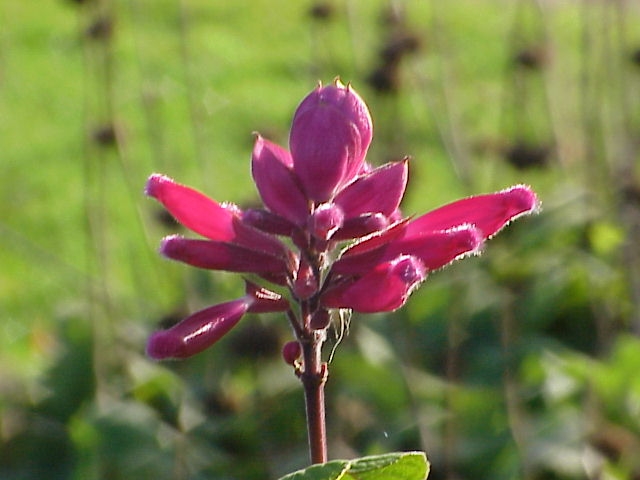Roseleaf Sage
(Salvia involucrata)
Roseleaf Sage (Salvia involucrata)
/
/

Kurt Stüber [1]
CC BY-SA 3.0
Image By:
Kurt Stüber [1]
Recorded By:
Copyright:
CC BY-SA 3.0
Copyright Notice:
Photo by: Kurt Stüber [1] | License Type: CC BY-SA 3.0 | License URL: http://creativecommons.org/licenses/by-sa/3.0/ | Uploader: Topjabot | Publisher: Wikimedia Commons | Title: Salvia_involucrata3.jpg | Notes: Transferred from Flickr via Flickr2commons |































Estimated Native Range
Summary
Salvia involucrata, commonly known as Roseleaf Sage, is a perennial herb native to cloud forests and pine-oak woodlands in Mexico. It can reach a height of 3-5 feet and a width of 2-3 feet. This plant is characterized by its square stems, large ovate leaves with a textured surface, and striking reddish, beetroot-colored flowers and bracts that bloom in late summer to fall. The flowers are tubular and arranged in whorls, providing a showy display that attracts hummingbirds and butterflies.
Roseleaf Sage is valued for its ornamental flowers, which add vibrant color to garden borders and beds. It is also used in pollinator gardens due to its attractiveness to wildlife. In cultivation, Roseleaf Sage requires good drainage, humus-enriched soil, and deep watering once a week. It tolerates partial sun but thrives in full sun, where it produces the most abundant blooms. While it is frost-tender, it can resprout from the base after light freezes. Pruning in early spring encourages bushier growth and more flowers. Propagation is typically done by division or cuttings, which can be rooted in late summer or early autumn. Gardeners should be aware that it can spread if conditions are ideal, and it may require management to keep it within bounds.CC BY-SA 4.0
Roseleaf Sage is valued for its ornamental flowers, which add vibrant color to garden borders and beds. It is also used in pollinator gardens due to its attractiveness to wildlife. In cultivation, Roseleaf Sage requires good drainage, humus-enriched soil, and deep watering once a week. It tolerates partial sun but thrives in full sun, where it produces the most abundant blooms. While it is frost-tender, it can resprout from the base after light freezes. Pruning in early spring encourages bushier growth and more flowers. Propagation is typically done by division or cuttings, which can be rooted in late summer or early autumn. Gardeners should be aware that it can spread if conditions are ideal, and it may require management to keep it within bounds.CC BY-SA 4.0
Plant Description
- Plant Type: Shrub, Herb
- Height: 3-5 feet
- Width: 2-3 feet
- Growth Rate: Moderate
- Flower Color: Pink
- Flowering Season: Spring, Winter
- Leaf Retention: Deciduous
Growth Requirements
- Sun: Full Sun, Part Shade
- Water: Medium
- Drainage: Medium, Fast
Common Uses
Bee Garden, Bird Garden, Butterfly Garden, Deer Resistant, Drought Tolerant, Fragrant, Groundcover, Hummingbird Garden, Low Maintenance, Rabbit Resistant, Salt Tolerant, Showy Flowers, Street Planting
Natural Habitat
Native to cloud forests and pine-oak woodlands in Mexico
Other Names
Common Names:
Scientific Names: , Salvia involucrata, Salvia laevigata, Salvia palafoxiana, Salvia ventricosa, Belospis laevigata, Salvia bethellii,
GBIF Accepted Name: Salvia involucrata Cav.